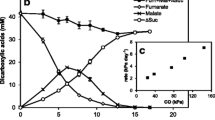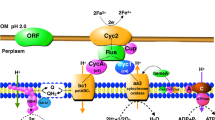Abstract
Geobacter species such as G. bremensis, G. pelophilus, and G. sulfurreducens are obligately anaerobic and grow in anoxic, non-reduced medium by fast reduction of soluble ferric citrate. In contrast, insoluble ferrihydrite was either only slowly or not reduced when supplied as electron acceptor in similar growth experiments. Ferrihydrite reduction was stimulated by addition of a reducing agent or by concomitant growth of secondary bacteria that were physiologically and phylogenetically as diverse as Escherichia coli, Lactococcus lactis, or Pseudomonas stutzeri. In control experiments with heat-inactivated Geobacter cells and viable secondary bacteria, no (E. coli, P. stutzeri) or only little (L. lactis) ferrihydrite was reduced. Redox indicator dyes showed that growing E. coli, P. stutzeri, or L. lactis cells lowered the redox potential of the medium in a similar way as a reducing agent did. The lowered redox potential was presumably the key factor that stimulated ferrihydrite reduction by all three Geobacter species. The observed differences in anoxic non-reduced medium with ferric citrate versus ferrihydrite as electron acceptor indicated that reduction of these electron acceptors involved different cellular components or different biochemical strategies. Furthermore, it appears that redox-sensitive components are involved, and/or that gene expression of components needed for ferrihydrite reduction is controlled by the redox state.



Similar content being viewed by others
References
Bauer CE, Elsen S, Bird TH (1999) Mechanisms for redox control of gene expression. Annu Rev Microbiol 53:495–523
Breznak JA, Costilow RN (1994) Physicochemical factors in growth. In: Gerhardt P, Murray RGE, Wood WA, Krieg NR (eds) Methods for general and molecular bacteriology. American Society for Microbiology, Washington, pp 137–154
Brookins DG (1988) Eh–pH diagrams for geochemistry. Springer, Berlin Heidelberg New York
Caccavo F Jr, Lonergan DJ, Lovley DR, Davis M, Stolz JF, McInerney MJ (1994) Geobacter sulfurreducens sp. nov., a hydrogen- and acetate-oxidizing dissimilatory metal-reducing microorganism. Appl Environ Microbiol 60:3752–3759
Doong R-A, Schink B (2002) Cysteine-mediated reductive dissolution of poorly crystalline iron(III) oxides by Geobacter sulfurreducens. Environ Sci Technol 36:2939–2945
Forsberg CW, Groleau D (1982) Stability of the endo-β-1,4-glucanase and β-1,4-glucosidase from Bacteroides succinogenes. Can J Microbiol 28:144–148
Giuliano C, Khan AW (1984) Cellulase and sugar formation by Bacteroides cellulosolvens, a newly isolated cellulolytic anaerobe. Appl Environ Microbiol 48:446–448
Guest JR, Green J, Irvine AS, Spiro S (1996) The FNR modulon and FNR-regulated gene expression. In: Lin ECC, Lybch AS (eds) Regulation of gene expression in Escherichia coli. Landes, Austin, pp 317–342
Jacob H-E (1970) Redox potential. In: Norris JR, Ribbons DW (eds) Methods in Microbiology, vol 2. Academic, New York, pp 92–123
Johnson EA, Sakajoh M, Halliwell G, Madia A, Demain AL (1982) Saccharification of complex cellulosic substrates by the cellulase system from Clostridium thermocellum. Appl Environ Microbiol 43:1125–1132
Lovley DR (1997) Microbial Fe(III) reduction in subsurface environments. FEMS Microbiol Rev 20:305–313
Lovley DR (2000) Fe(III) and Mn(IV) reduction. In: Lovley DR (ed) Environmental microbe–metal interactions. ASM, Washington, pp 3–30
Lovley DR, Phillips EJP (1986) Organic matter mineralization with reduction of ferric iron in anaerobic sediments. Appl Environ Microbiol 51:683–689
Nevin KP, Lovley DR (2000) Potential for nonenzymatic reduction of Fe(III) via electron shuttling in subsurface sediments. Environ Sci Technol 34:2472–2478
Pel R, Gottschal JC (1987) The effect of oxygen and sulfhydryl reagents on the hydrolysis and the fermentation of chitin by Clostridium 9.1. FEMS Microbiol Lett 44:59–62
Riffel A, Lucas F, Heeb P, Brandelli A (2003) Characterization of a new keratinolytic bacterium that completely degrades native feather keratin. Arch Microbiol 179:258–265
Sawers RG, Zalelein E, Böck A (1988) Two-dimensional gel electrophoretic analysis of Escherichia coli proteins: influence of various anaerobic growth conditions and the fnrgene product on cellular protein composition. Arch Microbiol 149:240–244
Smith PH, Hungate RE (1958) Isolation and characterization of Methanobacterium ruminatium n. sp. J Bacteriol 75:713–718
Snoeyenbos-West OL, Nevin KP, Anderson RT, Lovley DR (2000) Enrichment of Geobacter species in response to stimulation of Fe(III) reduction in sandy aquifer sediments. Microb Ecol 39:153–167
Stookey LL (1970) Ferrozine—a Ferrozine new spectrophotometric reagent for iron. Anal Chem 42:779–781
Straub KL, Buchholz-Cleven BEE (2001) Geobacter bremensis sp. nov. and Geobacter pelophilus sp. nov., two dissimilatory ferric iron reducing bacteria. Int J Syst Evol Bacteriol 51:1805–1808
Straub KL, Schink B (2003) Evaluation of electron-shuttling compounds in microbial ferric iron reduction. FEMS Microbiol Lett 220:229–233
Straub KL, Hanzlik M, Buchholz-Cleven BEE (1998) The use of biologically produced ferrihydrite for the isolation of novel iron-reducing bacteria. System Appl Microbiol 21:442–449
Straub KL, Benz M, Schink B (2001) Iron metabolism in anoxic environments at near neutral pH. FEMS Microbiol Ecol 34:181–186
Thamdrup B (2000) Bacterial manganese and iron reduction in aquatic sediments. In: Schink B (ed) Advances in microbial ecology, vol 16. Kluwer/Plenum, New York, pp 41–84
Unden G, Achebach S, Holighaus G, Tran HG, Wackwitz B, Zeuner Y (2002) Control of FNR function of Escherichia coli by O2 and reducing conditions. J Mol Microbiol Biotechnol 4:263–268
Widdel F, Bak F (1992) Gram-negative mesophilic sulfate-reducing bacteria. In: Balows A, Trüper HG, Dworkin M, Harder W, Schleifer K-H (eds) The prokaryotes, vol 2. Springer, Berlin Heidelberg New York, pp 3352–3378
Widdel F, Schnell S, Heising S, Ehrenreich A, Assmus B, Schink B (1993) Ferrous iron oxidation by anoxygenic phototrophic bacteria. Nature 362:834–836
Acknowledgments
We thank W.A. Schönhuber for fruitful discussions. R. Dippel, S. Gerhardt, D.R. Lovley, and D. Schmitt-Wagner are acknowledged for providing strains. This work was financed by the European Commission in the PURE project (EVK1-CT-1999-00030).
Author information
Authors and Affiliations
Corresponding author
Additional information
Dedicated to Prof. Dr. Dr. h.c. mult. Hans Günter Schlegel on the occasion of his 80th birthday.
Rights and permissions
About this article
Cite this article
Straub, K.L., Schink, B. Ferrihydrite reduction by Geobacter species is stimulated by secondary bacteria. Arch Microbiol 182, 175–181 (2004). https://doi.org/10.1007/s00203-004-0686-0
Received:
Revised:
Accepted:
Published:
Issue Date:
DOI: https://doi.org/10.1007/s00203-004-0686-0




